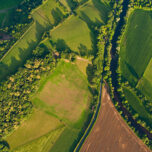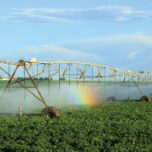The U.S. Environmental Protection Agency has been concerned about nitrates in drinking water since 1977, when it set an interim maximum contaminant level for drinking water of 10 milligrams per liter, the documented threshold to prevent blue baby syndrome. The EPA made this level official in 1991. However, these standards only prompted water cleanup at municipal drinking water facilities. They did nothing to prevent the pollution in the first place.
Rural residents often rely on groundwater that doesn’t go through a municipal drinking water facility, and therefore are disproportionately affected by nitrates. The 2013 California Water Board study identified about 4.1 million people in the state who rely solely on a contaminated groundwater source. Nearly all of that is treated for nitrates and other health hazards prior to distribution. But 2 million more Californians rely on groundwater from private wells or other water-supply systems not regulated by the state. People in Seville all rely on a single contaminated well. And because the average household income is just $14,000 a year, many families can’t afford to buy clean water.
Forty percent of the wells indicated evidence of human-caused nitrate pollution.
A study of groundwater used for public water supplies in San Joaquin Valley found nitrates above the legal limit in 2 percent to 7 percent of the aquifer systems and at moderate concentrations, above half the legal limit, in 9 percent to 20 percent. Statewide, the U.S. Geological Survey detected high concentrations of nitrates in groundwater typically used for public water supply in about 10 percent of aquifers.
Most public-supply aquifers range from about 200 to 800 feet deep, says Jennifer Shelton, a USGS hydrologist who is working on the research. Shelton noted that study reports so far do not include private domestic wells, such as the one used by Seville, which are generally shallower. Shallower groundwater tends to have higher concentrations of nitrates than deeper water, she says.
Nationwide, some 46 million people get their water from private wells. In the early 1990s, the USGS National Water-Quality Assessment Program sampled domestic wells in 48 states. It found that concentrations of nitrate were greater than the legal limit in about 4 percent of the wells. Forty percent of the wells indicated evidence of human-caused nitrate pollution. Those figures may be higher today, as several other studies show that nitrate pollution is increasing in groundwater.
Leading the Way
In the absence of federal action, states can regulate agricultural pollution. Some states are encouraging voluntary measures, such as adopting precision agriculture, to reduce the amount of nutrients that end up in the water. California, however, is leading the way.
The state is divided into nine regional water quality control boards that are semi-autonomous from the State Water Board. Beginning in 2002, seven of the nine began to regulate the effects of irrigation runoff to surface water. They required growers to monitor water quality and to clean up pollution.
The recent flurry of activity surrounding groundwater pollution was initiated with a 2008 state senate bill that prompted the State Water Board’s just-released study on groundwater. But ahead of that, some of the regional water boards began to regulate growers who discharge water from irrigated lands into groundwater and surface water.
Joe Karkoski is program manager for the Central Valley Regional Water Quality Control Board’s irrigated lands program. The Central Valley began to regulate growers’ discharges into groundwater and surface water last year.
Groundwater regulation is particularly difficult because legacy pollution mixes with new. When testing groundwater for contamination, “what you’re observing in the sample could have occurred last week, last month or 50 years ago,” says Karkoski. So instead of trying to link specific groundwater pollution to specific growers, the Central Valley Water Board is trying to ensure that today’s farmers don’t pollute.
The board is beginning to require growers to evaluate their management practices to ensure they are protecting groundwater and surface water. In areas impacted by nitrates, growers will need to develop nitrogen management plans certified by a qualified crop advisor or attend special training to self-certify. The board will inspect self-certifiers, says Karkoski.
Best practices are being determined now through studies that will take several years to complete. Scientists will look at nitrogen use efficiency, defined as a ratio of total nitrogen applied over crop need. They will also examine irrigation efficiency. “Nitrates don’t move on their own. They move with water,” says Karkoski.
Related Posts
Ensia shares solutions-focused stories free of charge through our online magazine and partner media. That means audiences around the world have ready access to stories that can — and do — help them shape a better future. If you value our work, please show your support today.
Yes, I'll support Ensia!



